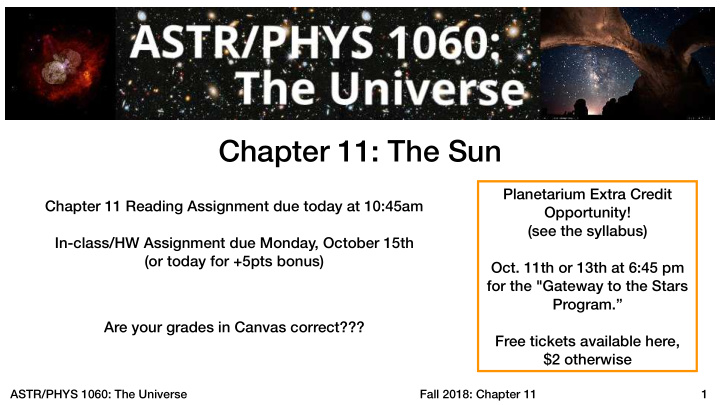



Chapter 11: The Sun Planetarium Extra Credit Chapter 11 Reading Assignment due today at 10:45am Opportunity! (see the syllabus) In-class/HW Assignment due Monday, October 15th (or today for +5pts bonus) Oct. 11th or 13th at 6:45 pm for the "Gateway to the Stars Program.” Are your grades in Canvas correct??? Free tickets available here, $2 otherwise ASTR/PHYS 1060: The Universe Fall 2018: Chapter 11 � 1
Midterm 1 Results ASTR/PHYS 1060: The Universe Fall 2018: Chapter 11 � 2
Multiple Choice Questions ASTR/PHYS 1060: The Universe Fall 2018: Chapter 11 � 3
Kepler’s Law Short Answer Question Semi-major axis = 4 AU 8 AU ASTR/PHYS 1060: The Universe Fall 2018: Chapter 11 � 4
Why does the Sun shine? https://www.youtube.com/watch?v=3JdWlSF195Y ASTR/PHYS 1060: The Universe Fall 2018: Chapter 11 � 5
A Small Correction… https://www.youtube.com/watch?v=sLkGSV9WDMA ASTR/PHYS 1060: The Universe Fall 2018: Chapter 11 � 6
The Sun on Sun Facts Wednesday • Diameter: 1.4 million km (~100x Earth’s) • Mass: 2x10 30 kg (300,000x Earth’s) • Total Luminosity: 4x10 26 Watts • Energy Reaching Earth: 1400 Watts/meter 2 • Surface Temperature: 5800 K Solar Dynamics Observatory https://sdo.gsfc.nasa.gov ASTR/PHYS 1060: The Universe Fall 2018: Chapter 11 � 7
The greatest pressure is experienced by the… A) Diver B) Mermaid C) Bathysphere D) Loch Ness Llama ASTR/PHYS 1060: The Universe Fall 2018: Chapter 11 � 8
Hydrostatic Equilibrium ASTR/PHYS 1060: The Universe Fall 2018: Chapter 11 � 9
ASTR/PHYS 1060: The Universe Fall 2018: Chapter 11 � 10
Pressure, Temperature, Density, Energy Produced all change with radius ASTR/PHYS 1060: The Universe Fall 2018: Chapter 11 � 11
The Sun’s Luminosity Comes From: A) Chemical Burning (loss of electron energy) B) Nuclear Fusion C) Gravitational Collapse ASTR/PHYS 1060: The Universe Fall 2018: Chapter 11 � 12
Fusion happens at the center of the sun because: A) High Temperature B) High Density C) High Density & Temperature ASTR/PHYS 1060: The Universe Fall 2018: Chapter 11 � 13
Higher Temperature —> High Density —> More likely to run into things Faster Movement Hot Cold ASTR/PHYS 1060: The Universe Fall 2018: Chapter 11 � 14
Higher temperature makes collisions possible Higher density makes it more likely for collisions to happen I n c r e a s i n g T e m p e r a t u r e ASTR/PHYS 1060: The Universe Fall 2018: Chapter 11 � 15
Hydrogen burning via the p-p chain ASTR/PHYS 1060: The Universe Fall 2018: Chapter 11 � 16
Energy is conserved (and E=mc 2 ), so… A) then 4 Hydrogen atoms must weigh more than one Helium atom B) then 4 Hydrogen atoms must weigh less than one Helium atom ASTR/PHYS 1060: The Universe Fall 2018: Chapter 11 � 17
Energy from Mass ASTR/PHYS 1060: The Universe Fall 2018: Chapter 11 � 18
Photons are created in the core and move outward to the surface ASTR/PHYS 1060: The Universe Fall 2018: Chapter 11 � 19
How light escapes the Sun ASTR/PHYS 1060: The Universe Fall 2018: Chapter 11 � 20
How light escapes the Sun https://www.youtube.com/watch?v=W_Scoj4HqCQ ASTR/PHYS 1060: The Universe Fall 2018: Chapter 11 � 21
We learn about the Sun’s interior from “sunquakes”: helioseismology http://www.youtube.com/watch?v=YxUsr4vp3yM ASTR/PHYS 1060: The Universe Fall 2018: Chapter 11 � 22
Zones of the Sun High Resolution Solar Spectrum ASTR/PHYS 1060: The Universe Fall 2018: Chapter 11 � 23
Sun’s Atmosphere Limb Darkening ASTR/PHYS 1060: The Universe Fall 2018: Chapter 11 � 24
Recommend
More recommend